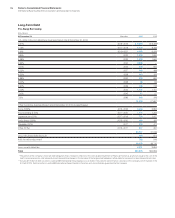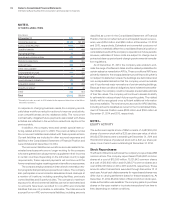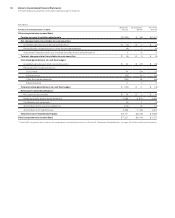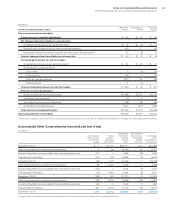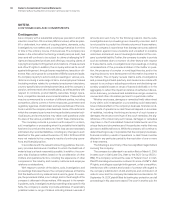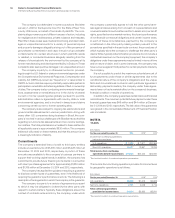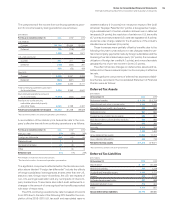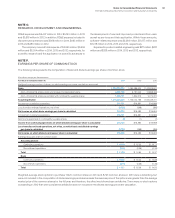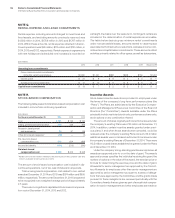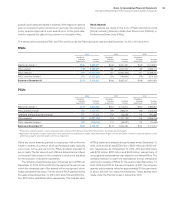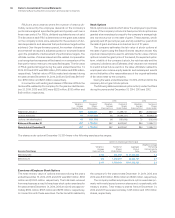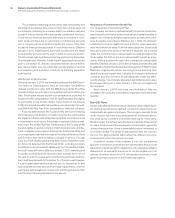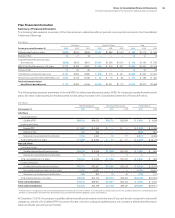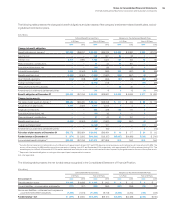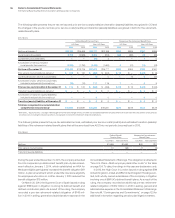IBM 2014 Annual Report Download - page 127
Download and view the complete annual report
Please find page 127 of the 2014 IBM annual report below. You can navigate through the pages in the report by either clicking on the pages listed below, or by using the keyword search tool below to find specific information within the annual report.
Notes to Consolidated Financial Statements
International Business Machines Corporation and Subsidiary Companies
126
For income tax return purposes, the company has foreign and
domestic loss carryforwards, the tax effect of which is $579 mil-
lion, as well as domestic and foreign credit carryforwards of $965
million. Substantially all of these carryforwards are available for at
least two years or are available for 10years or more.
The valuation allowance at December31, 2014 principally
applies to certain foreign, state and local loss carryforwards that,
in the opinion of management, are more likely than not to expire
unutilized. However, to the extent that tax benefits related to these
carry forwards are realized in the future, the reduction in the valu-
ation allowance will reduce income tax expense.
The amount of unrecognized tax benefits at December31, 2014
increased by $646 million in 2014 to $5,104 million. A reconciliation
of the beginning and ending amount of unrecognized tax benefits
is as follows:
($ in millions)
2014 2013 2012
Balance at January1 $4,458 $ 5,672 $5,575
Additions based on tax positions
related to the current year 697 829 401
Additions for tax positions
of prior years 586 417 215
Reductions for tax positions
of prior years (including impacts
due to a lapse in statute) (579) (2,201) (425)
Settlements (58) (259) (94)
Balance at December 31 $5,104 $ 4,458 $5,672
The additions to unrecognized tax benefits related to the current
and prior years are primarily attributable to non-U.S. issues, certain
tax incentives and credits, divestitures, acquisition-related matters
and state issues. The settlements and reductions to unrecognized
tax benefits for tax positions of prior years are primarily attribut-
able to currency, non-U.S. audits and impacts due to lapses in
statutes of limitation.
In April 2010, the company appealed the determination of the
Japan Tax Authorities with respect to certain foreign tax losses.
The tax benefit of these losses totals $1,000 million as of Decem-
ber31, 2014. The 2014 decrease of $141 million was driven by
currency and has been included in the 2014 reductions for tax
positions of prior years. In April 2011, the company received notifi-
cation that the appeal was denied, and in June 2011, the company
filed a lawsuit challenging this decision. In May 2014, the Tokyo
District Court ruled in favor of the company. The Japanese gov-
ernment has appealed the ruling to the Tokyo High Court. No final
determination has been reached on this matter.
The liability at December31, 2014 of $5,104 million can be
reduced by $875 million of offsetting tax benefits associated with
the correlative effects of potential transfer pricing adjustments, U.S.
tax credits, state income taxes and timing adjustments. The net
amount of $4,229 million, if recognized, would favorably affect the
company’s effective tax rate. The net amounts at December31,
2013 and 2012 were $3,902 million and $5,099 million, respectively.
Interest and penalties related to income tax liabilities are
included in income tax expense. During the year ended Decem-
ber31, 2014, the company recognized $216 million in interest
expense and penalties; in 2013, the company recognized a benefit
of $93 million in interest expense and penalties, and in 2012, the
company recognized $134 million in interest expense and penal-
ties. The company has $593 million for the payment of interest
and penalties accrued at December31, 2014, and had $417 million
accrued at December31, 2013.
Within the next 12 months, the company believes it is reason-
ably possible that the total amount of unrecognized tax benefits
associated with certain positions may be significantly reduced.
The potential decrease in the amount of unrecognized tax benefits
is primarily associated with the anticipated resolution of the com-
pany’s U.S. income tax audit for 2011 and 2012, as well as various
non-U.S. audits. The company estimates that the unrecognized tax
benefits at December31, 2014 could be reduced by approximately
$1 billion.
The company is subject to taxation in the U.S. and various
state and foreign jurisdictions. With respect to major U.S. state
and foreign taxing jurisdictions, the company is generally no longer
subject to tax examinations for years prior to 2009. The company is
no longer subject to income tax examination of its U.S. federal tax
return for years prior to 2011. The open years contain matters that
could be subject to differing interpretations of applicable tax laws
and regulations related to the amount and/or timing of income,
deductions and tax credits. Although the outcome of tax audits is
always uncertain, the company believes that adequate amounts of
tax and interest have been provided for any significant adjustments
that are expected to result for these years.
In the fourth quarter of 2013, the company received a draft tax
assessment notice for approximately $866 million (approximately
$850 million at 2014 year-end currency rates) from the Indian Tax
Authorities for 2009. The company believes it will prevail on these
matters and that this amount is not a meaningful indicator of liabil-
ity. At December31, 2014, the company has recorded $471 million
as prepaid income taxes in India. A significant portion of this bal-
ance represents cash tax deposits paid over time to protect the
company’s right to appeal various income tax assessments made
by the Indian Tax Authorities.
In the first quarter of 2014, the IRS commenced its audit of
the company’s U.S. tax returns for 2011 and 2012. The company
anticipates that this audit will be completed by the end of 2015.
The company has not provided deferred taxes on $61.4 billion
of undistributed earnings of non-U.S. subsidiaries at December31,
2014, as it is the company’s policy to indefinitely reinvest these
earnings in non-U.S. operations. However, the company periodi
-
cally repatriates a portion of these earnings to the extent that it
does not incur an additional U.S. tax liability. Quantification of the
deferred tax liability, if any, associated with indefinitely reinvested
earnings is not practicable.


